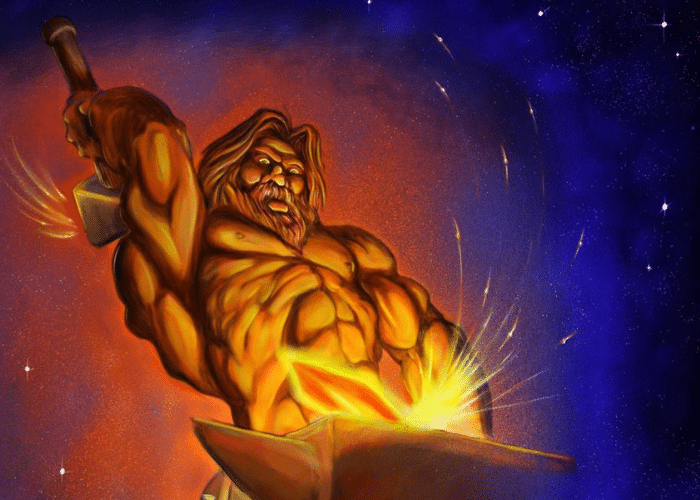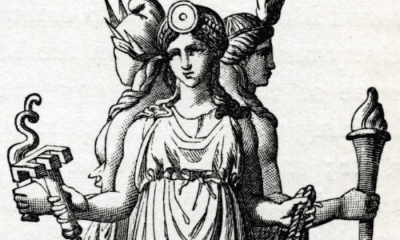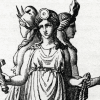
Greek
Who is Hephaestus?
Who is Hephaestus?
Hephaestus was the smith of the gods. He did not stand out for his profession and skill alone, though. Read on to find out what a physically imperfect god can tell us about Greek culture and the hazards of his job!
The gods of Olympus were usually physically perfect specimens whose divine aura made them far-removed from the ordinary people of Greece. They were so beautiful that no human could ever hope to match them.
One god, however, did not seem to fit that type. Hephaestus was not only noteworthy for being a god who worked with his hands, but also for the fact that he was not at all physically perfect.
Hephaestus was usually described as “lame,” which in the ancient world typically described someone with a limp. Artists went further, however, sometimes showing him with a hunchback, club foot, or other type of obvious physical deformity.
The physicality of Hephaestus was so anathema to the ideals of the gods that he was thrown from Olympus as a child. Remarkably, he not only returned but did so as the husband of the goddess of beauty.
So how did a physically disabled smith become a Greek god? The answer lies in an ancient archetype and an unexpected side effect of working in an ancient forge.
Hephaestus the Lame Smith God
A few myths claimed that Hephaestus was the son of Zeus and Hera, their second after Ares. Others, however, said that he was Hera’s alone and was her first child.
When Athena was born out of Zeus’s head, his wife was determined to make a powerful child of her own so that she would be on even footing with her husband. The result, however, was a disappointment to the queen of the gods.
Unlike Athena, Hephaestus was not born strong and physically perfect. He was misshapen and lame, a fact that horrified his mother to such an extent that she threw the child down from Olympus.
Some versions of the story claimed that Hephaestus was not deformed at birth, but was simply not as attractive as Hera wanted. His limp was caused by the fall from the top of the mountain itself, only furthering his imperfection.
Hephaestus was rescued by the Titaness Thetis who took pity on him. She and the Oceananids took the young god to Lemnos, where the famously inventive people taught him to be a skilled smith and craftsman.
Hephaestus had his revenge on his mother when he crafted her a beautiful golden throne. As soon as she sat upon it, Hera was seized by unbreakable fetters that none of the gods could undo.
Zeus swore that whatever got brought Hephaestus to Olympus to face his crime would be rewarded with a marriage to Aphrodite, the goddess of beauty. Hephaestus turned himself in, and by bringing himself to Olympus fulfilled the wording of Zeus’s decree.
His marriage to Aphrodite would be short-lived, however. When he found out his bride was having an affair with Ares he again used his unbreakable chains to trap them in bed together and invited the other gods to come to laugh at their humiliation.
When he and Aphrodite parted ways, he remarried. Aglaia, the youngest of the Charites (Graces) became his wife and, from all accounts, they had a much more harmonious marriage than his first.
As the smith of Olympus, Hephaestus was most often shown in both art and literature while he was at work. He created some of the gods’ most powerful weapons and most durable armor.
He was also skilled in making fine jewelry, however. According to some stories, he got his final revenge on Aphrodite and Ares by giving their daughter Harmonia a cursed necklace as a wedding gift.
In addition to his four daughters with Aglaea, Hephaestus was also the father of one son who was born of Gaia and adopted by Athena.
According to an Athenian legend, the goddess was in his workshop to have her armor repaired when the smith god tried to force himself on her. She pushed him away, but some of his bodily fluids fell into the dirt at her feet.
A child was created from this event who was named Erichthonius. Under Athena’s guidance, he became one of the founding kings of the city of Athens.
Erichthonius also inherited some traits from his father. He was sometimes said to be disabled as well and was credited with many inventions, including the four-horse chariot that allowed him to travel across his city without walking.
Like many ancient smith gods, he was also associated with volcanoes. The heat of a volcano reminded ancient people of a forge and Lemnos, where he spent much of his time, was the home of an active volcano.
Hephaestus spent more time on earth than most of the gods. He frequently traveled back to Lemnos, abandoning his wondrous forge at Olympus for simpler work among men.
My Modern Interpretation
Hephaestus was unique among the gods in that he did not embody an ideal of perfection. The other gods were usually shown as physically perfect men and women, but Hephaestus was explicitly singled out as disabled and ugly.
The Greeks strove for perfection and considered beauty and health to be a reflection of moral righteousness and nobility. The smith, often shown with a hunched back or shrivelled foot, was neither attractive nor a model of health.
This was not only considered terrible by the standards of the gods. The people of Greece were known to leave infants with birth defects to die of exposure, just as Hera did.
Outside of Greece, however, the image of the lame smith was a common one. Gods from India, Scandinavia, Egypt, and other world religions fit into this common archetype.
There may be a very real historical reason so many smith gods walked with a limp. It was not a reflection of their worth, but rather a side effect of their career.
The common way to make bronze is by melting an alloy of two main metals, copper and tin. The resulting metal is stronger than either of these on their own, which made it valuable in the ancient world.
When tin was scarce, however, another material could be used to create a product with a similar appearance and durability. Arsenic could be combined with copper instead of tin to create a metal referred to as arsenical bronze.
We know from archaeological finds that the use of arsenic in Bronze Age metalworking was widespread. The limitations of mining at the time and frequent trade interruptions meant that tin was often in short supply.
Using this material could be disastrous for the smiths that worked with it, however. Many smiths suffered from arsenicosis – arsenic poisoning.
Some of the most common ailments associated with arsenic poisoning are skin cancer and neuropathy, or damage to the nerves of the arms and legs. Nerve damage often led to smiths having a distinctive limp.
The cancers that were often caused by arsenic poisoning would only further the damage already done by working in a hot forge. Burns and heat would already make a smith prone to being red-faced and scarred, while skin cancer could cause further visible problems.
While the myths as we know them were developed in the Iron Age, the archetype of the limping smith god was set long before the Greeks wrote their stories down. The god’s disability, a sign of his profession, continued to be told in the oral tradition even after human smiths were no longer impacted by making arsenical bronze.
In Summary
Hephaestus was the smith of the gods. Unlike the other Olympians, he was depicted as disabled and often physically deformed.
He was the son of Hera, who gave birth to him with or without the involvement of Zeus depending on the source. His mother was so upset over her imperfect child that she banished him from Olympus and threw him to earth.
He was saved and living among humans learned to be an exceptionally-skilled craftsman. His metalworking was uniquely strong and beautiful.
Hephaestus returned to Olympus after tricking his mother into being held captive by one of his creations. In the process he also earned the right to marry Aphrodite.
The marriage did not last long, however, and afterward he was said to be more happily married to one of the Charites.
He worked on Olympus, crafting both practical objects and beautiful finery for the gods. He was even said in some legends to have been the creator of Pandora, the first woman.
Hephaestus stood out among the other gods for his physical differences. In a society that valued perfection and beauty, it seems unusual that the Greeks would have worshipped a god who was explicitly called ugly and misshapen.
The archetype of the lame smith long predates Greek culture, however. It is ancient and widespread, rooted in the actual metalworking practices of the Bronze Age.
Due to a shortage of tin, arsenic was often used in the creation of bronze alloy. Arsenic poisoning caused many metalworkers to suffer from skin cancer and nerve damage.
The archetype of the lame smith continued long after the practice of using heavy amounts of arsenic ended. The Greeks did not know what caused Hephaestus to limp, or that it was a reflection of the hazards of his profession.



